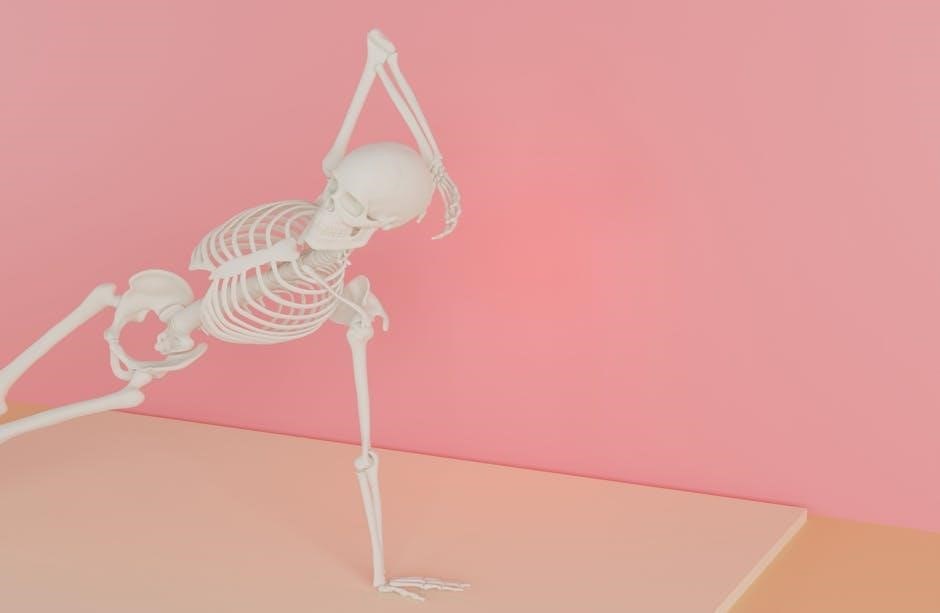Visual analogies are powerful tools that simplify complex anatomical concepts by relating them to familiar objects or systems, enhancing understanding and retention for anatomy students.
What Are Visual Analogies?
Visual analogies are creative tools that simplify complex anatomical structures by comparing them to familiar objects or systems. They help learners relate abstract biological concepts to everyday experiences, making them more relatable and easier to understand. For example, the nervous system might be likened to a computer network, while the circulatory system could resemble a highway system. These comparisons create vivid mental images, allowing students to grasp intricate details more effectively. By bridging the gap between the unknown and the known, visual analogies become powerful aids in anatomy education, transforming daunting subjects into accessible and memorable lessons.
These analogies are particularly beneficial for students, as they provide a framework for organizing information and enhancing retention. They also encourage active thinking and engagement with the material, fostering a deeper understanding of human anatomy.
Why Use Visual Analogies to Study Anatomy?
Visual analogies are a highly effective method for studying anatomy because they make complex structures more relatable and easier to understand. By comparing intricate biological systems to familiar objects or concepts, learners can grasp difficult ideas more intuitively. This approach enhances memory retention, as the association with known images or processes creates vivid mental connections. Visual analogies also reduce the intimidation factor of anatomy, breaking down overwhelming details into digestible parts; They encourage active learning, as students engage with the material by drawing parallels and visualizing relationships. Ultimately, visual analogies provide a powerful framework for understanding and remembering anatomy, making them an invaluable tool for students and educators alike.

The Benefits of Visual Analogies for Learning Anatomy
Visual analogies simplify complex anatomy, enhance memory retention, and improve spatial awareness, making learning engaging and effective for students of all levels.
Improved Memory Retention
Visual analogies significantly enhance memory retention by associating complex anatomical structures with familiar, relatable concepts. By linking abstract biological systems to everyday objects or experiences, learners can better encode information in their long-term memory. For example, comparing bones to a building’s scaffolding or neurons to electrical wires creates vivid mental images, making anatomical details easier to recall. This technique leverages the brain’s preference for visual and associative learning, reducing the cognitive load of memorizing isolated facts. Over time, these analogies become mental frameworks, helping students retrieve information more efficiently during exams or clinical practice. The engaging nature of visual comparisons also sustains interest, fostering a deeper connection to the material and improving overall academic performance. Thus, visual analogies serve as powerful tools for retaining anatomical knowledge effectively and enduringly.

Simplifying Complex Structures
Visual analogies are invaluable for breaking down intricate anatomical systems into more digestible concepts. By comparing complex structures to familiar objects or processes, learners can better understand their function and organization. For instance, likening the skeletal system to a building’s framework or the nervous system to a computer network transforms abstract ideas into relatable models. This approach reduces cognitive overload, making it easier to visualize how components interact. For example, the circulatory system can be seen as a highway system, with blood vessels as roads and the heart as a pump, simplifying the flow of blood. Similarly, the digestive system can be compared to a production line, where food is processed step-by-step. These analogies provide a clear, tangible way to grasp complex anatomy, making learning more intuitive and effective. They help bridge the gap between abstract biological concepts and real-world understanding.
Enhancing Spatial Awareness
Visual analogies play a crucial role in enhancing spatial awareness, which is essential for understanding the three-dimensional arrangement of anatomical structures. By relating complex shapes and relationships to familiar objects, learners can better visualize how different parts of the body are positioned and interconnected. For example, comparing the ribcage to a dome or the spinal column to a flexible rod helps in grasping their spatial orientation. This spatial understanding is vital for medical professionals, such as surgeons or physical therapists, who need to comprehend the precise locations and relationships of organs and tissues. Visual analogies also aid in imagining how structures move and interact, making it easier to reconstruct mental models of the body. This skill is particularly useful for navigating intricate regions like the pelvis or abdominal cavity, where organs are tightly packed and spatial relationships are critical. Enhancing spatial awareness through visual analogies improves both comprehension and practical application of anatomical knowledge.

Visual Analogies for Major Body Systems
Visual analogies help simplify complex body systems by comparing them to familiar concepts. The nervous system resembles a computer network, while the circulatory system mirrors a highway system, and the respiratory system acts like bellows. These comparisons make intricate functions more relatable and easier to understand.
The Nervous System: The Body’s “Computer Network”
The nervous system, often likened to a computer network, processes and transmits information across the body. Just as a network relies on cables and routers, nerves act as pathways for signals. The brain serves as the central server, coordinating data and directing responses. Neurons function like data packets, transmitting signals through synapses, which act as connection points. This analogy helps visualize how the nervous system integrates and communicates, enabling functions like movement, sensation, and thought. Damage to this “network” can disrupt communication, similar to a system crash, highlighting the importance of its integrity in maintaining bodily functions. This comparison simplifies the complexity of neural communication, making it relatable and easier to comprehend for learners.
The Circulatory System: The “Highway System” of the Body
The circulatory system, much like a highway network, transports essential resources throughout the body. Arteries act as highways, carrying oxygen-rich blood away from the heart, while veins function as return routes, bringing oxygen-depleted blood back. Capillaries are like local roads, delivering nutrients to cells and collecting waste. The heart serves as the central pump, ensuring continuous flow, akin to traffic lights managing the movement of vehicles. Blood cells resemble different types of vehicles, with red blood cells carrying oxygen and nutrients, and white blood cells acting as emergency responders. Just as highways require maintenance to prevent congestion, the circulatory system must remain healthy to avoid blockages, such as those caused by plaque buildup in arteries, which can lead to conditions like atherosclerosis. This analogy helps learners grasp how the circulatory system efficiently distributes resources and maintains overall health.
The Respiratory System: The “Bellows” of the Body
The respiratory system operates like a bellows, expanding and contracting to move air in and out of the body. The nose and mouth act as the opening of the bellows, drawing in air. The diaphragm and rib muscles function like the handles, controlling the movement to inflate and deflate the “bellows chamber”—the lungs. The trachea and bronchi resemble the hoses, directing air to the alveoli, where gas exchange occurs. Just as a bellows mixes air with fuel for combustion, the alveoli mix oxygen with blood for energy production. The capillaries surrounding the alveoli act like the flames, utilizing the oxygen delivered. This analogy simplifies the complex process of breathing, making it easier to visualize and understand how the respiratory system supplies oxygen to the body. It also highlights the importance of proper “airflow” for overall health.
The Digestive System: The “Production Line” of Nutrient Absorption

The digestive system functions like a highly efficient production line, processing food to extract nutrients. The mouth acts as the intake, where food is broken down into “raw materials” by teeth and enzymes. The esophagus serves as the conveyor belt, transporting the mixture to the “processing plant”—the stomach, where acids and enzymes further break it down. The small intestine is the “assembly line,” absorbing nutrients into the bloodstream, while the large intestine packages water and waste for elimination. This analogy highlights how the digestive system systematically transforms food into energy and waste, much like a factory produces goods. It simplifies the complex process of digestion, making it easier to visualize and understand the role of each “station” in nutrient absorption.

Deep Dive into Specific Anatomy
This section explores the intricate details of major anatomical systems, using visual analogies to clarify complex structures and their functions, enhancing understanding through relatable comparisons.
The Skeletal System: The “Framework” of the Body
The skeletal system serves as the body’s structural foundation, much like a building’s framework. Bones act as sturdy beams, providing support and protection for vital organs. For instance, the skull shields the brain, while the ribcage safeguards the heart and lungs. Joints function like hinges or ball-and-socket mechanisms, enabling movement. The spine, a flexible yet robust column, supports the torso and protects the spinal cord. Even the smallest bones, like those in the hands and feet, contribute to dexterity and balance. This framework allows the body to stand upright and move efficiently. By visualizing bones as interconnected beams and joints as movable parts, learners can better grasp how the skeletal system maintains posture and facilitates motion. This analogy simplifies the complexity of bone structure and function, making it easier to understand and remember.
The Muscular System: The “Engine” of Movement
The muscular system is the body’s “engine,” driving movement, maintaining posture, and regulating body temperature. Just as a car engine generates power, muscles produce energy to propel the body. Skeletal muscles, like pistons, pull on bones to create motion, while smooth muscles function akin to flexible hoses, adjusting flow in internal systems. Cardiac muscle acts as the engine’s core, tirelessly pumping blood. This system’s efficiency relies on coordination, much like how engine components work together. By envisioning muscles as an engine, learners can better understand their role in powering movement and maintaining bodily functions. This analogy highlights the muscular system’s dynamic nature and its essential role in daily activities, making complex concepts more accessible and memorable for students.
The Endocrine System: The “Communication Network” of Hormones
The endocrine system acts as the body’s “communication network,” using hormones to transmit vital signals between cells, tissues, and organs. Similar to a high-speed internet network, hormones are like data packets, carrying specific instructions to target locations. Glands, such as the pancreas and thyroid, function as “servers,” producing and distributing these chemical messengers. The bloodstream serves as the “fiber-optic cable,” ensuring rapid delivery of hormones to their destinations. This system enables precise regulation of growth, metabolism, and reproductive processes. By likening the endocrine system to a communication network, learners can grasp how hormones coordinate bodily functions, maintaining balance and enabling life-sustaining activities. This analogy simplifies the intricate processes, making them easier to understand and remember.
The Reproductive System: The “Cycle of Life”
The reproductive system can be likened to a meticulously designed “cycle of life,” ensuring the continuation of species through precise and coordinated processes. Like a clockwork mechanism, it operates in a rhythmic and orderly fashion, with each component playing a vital role. The ovaries and testes act as “factories,” producing gametes essential for reproduction. The uterus functions as a “nurturing sanctuary,” providing a safe environment for fetal development. Hormones, such as estrogen and testosterone, serve as “conductors,” orchestrating the entire process. This analogy highlights the system’s purpose of perpetuating life, emphasizing its intricate yet harmonious design. By visualizing it as a cycle, learners can better understand the interconnected stages and functions that sustain life and enable the passage of genetic material to future generations.

Advanced Analogies for Complex Structures
Advanced analogies transform intricate anatomical structures into relatable concepts, bridging the gap between complexity and comprehension. These comparisons unlock deeper understanding of the body’s sophisticated systems.

The Brain: The “Command Center” of the Body
The brain, often likened to a high-tech computer or command center, orchestrates the body’s functions with precision. Just as a computer processes data, the brain interprets sensory input, controls movement, and manages complex thought processes. The cerebral cortex, resembling a vast circuit board, handles decision-making, while the basal ganglia act like coordinators, ensuring smooth motor functions. The hippocampus, akin to a data storage unit, processes memories. neurotransmitters, like messengers, transmit signals across synapses, enabling communication between neurons. This analogy simplifies the brain’s intricate workings, making it easier to grasp its role as the body’s central control system. By visualizing the brain as a command center, learners can better understand its essential functions and interconnected systems.
The Heart: The “Pump Station” of the Circulatory System
The heart functions as the circulatory system’s “pump station,” continuously propelling blood through a vast network of vessels. Like a mechanical pump, it generates the pressure needed to distribute oxygenated blood to tissues and organs. The heart’s chambers—atria and ventricles—act like intake and pumping stations, ensuring efficient blood flow. Valves prevent backflow, maintaining a one-way direction, similar to how a pump station regulates fluid movement. This analogy highlights the heart’s role in sustaining life by delivering essential nutrients and oxygen, much like a pump station supplies resources to a city. By envisioning the heart as a pump station, learners can better grasp its critical function in maintaining circulation and overall health.

The Lungs: The “Air Sacs” of the Respiratory System
The lungs can be visualized as “air sacs” that expand and deflate to facilitate breathing, much like inflatable balloons. Their elastic tissues allow them to stretch during inhalation and recoil during exhalation, ensuring efficient gas exchange. The alveoli, tiny sacs within the lungs, resemble clusters of grapes, where oxygen diffuses into the bloodstream and carbon dioxide is removed. This analogy simplifies the complex process of respiration, making it easier to comprehend how the lungs act as dynamic, flexible containers essential for exchanging gases. By likening the lungs to air sacs, learners can better understand their role in maintaining oxygen supply and overall respiratory function;
The Liver: The “Detox Filter” of the Body
The liver functions as the body’s “detox filter,” purifying blood by removing harmful substances like toxins, drugs, and metabolic waste. Like a water filter cleans impurities from drinking water, the liver processes blood from the digestive tract, detoxifying chemicals and metabolizing drugs. Its intricate network of cells and blood vessels acts as a multi-stage filtration system, ensuring harmful substances are neutralized or excreted. This analogy highlights the liver’s critical role in maintaining the body’s internal balance and overall health. By visualizing the liver as a filter, learners can better grasp its essential function in protecting the body from toxins and waste products.

Practical Applications of Visual Analogies
Visual analogies are invaluable in education, enhancing understanding through relatable comparisons. They aid in creating engaging study materials, facilitating easier retention of complex anatomical concepts for learners.
Using Analogies in Study Groups
Visual analogies are a powerful tool for collaborative learning in study groups. By simplifying complex anatomical concepts into relatable comparisons, they foster engaging discussions and active participation. Group members can collectively visualize structures, such as comparing the nervous system to a computer network, to better grasp their functions and interconnections. Analogies also encourage problem-solving and critical thinking, as students can draw parallels and challenge one another to refine their understanding. Sharing analogies within a group enhances retention, as hearing different perspectives strengthens memory recall. This collaborative approach not only deepens individual comprehension but also creates a shared visual framework for the entire group, making study sessions more effective and enjoyable. Incorporating analogies into group work can significantly improve overall learning outcomes.
Creating Personal Visual Aids
Creating personal visual aids is a highly effective way to reinforce anatomical concepts using visual analogies. By designing custom diagrams or charts, learners can tailor visuals to their unique understanding and learning style. For example, drawing the skeletal system as a “framework” or the circulatory system as a “highway map” helps solidify these comparisons. Incorporating colors, labels, and simple symbols makes the visuals more engaging. These aids can be used for self-study or as flashcards, enhancing active learning and memory retention. Digital tools like mind-mapping software or sketching apps can also be utilized for more detailed and organized visuals. Personalizing these aids ensures they align with individual learning needs, making them a valuable resource for mastering anatomy. This hands-on approach fosters deeper engagement and long-term retention of complex concepts.
Integrating Analogies into Exam Preparation
Integrating visual analogies into exam preparation is a powerful strategy to enhance performance in anatomy exams; By associating complex anatomical structures with familiar concepts, students can better recall information under time constraints. For instance, thinking of the nervous system as a “computer network” or the circulatory system as a “highway system” simplifies identification and organization of key details. Mnemonics and memory aids based on analogies can be used to create flashcards or concept maps, making study sessions more efficient. Practicing with analogy-based practice questions also helps students apply their knowledge in real exam scenarios. This approach reduces exam anxiety by providing a mental framework for quick recall, ensuring that even under pressure, visual analogies act as reliable memory triggers. Regular review of these analogies strengthens long-term retention and exam readiness.
Visual analogies empower learners to grasp human anatomy by transforming complexity into relatable concepts, fostering deeper understanding and engagement while enhancing retention for future studies.
Final Thoughts on the Power of Visual Analogies
Visual analogies are a transformative tool for understanding human anatomy, bridging the gap between abstract concepts and real-world applications. By linking complex structures to familiar objects or systems, learners can grasp relationships and functions more intuitively. This approach not only enhances memory retention but also fosters spatial awareness and critical thinking. The versatility of visual analogies makes them accessible to diverse learning styles, ensuring that anatomy becomes less intimidating and more engaging. Their application extends beyond education, aiding professionals in communicating complex ideas effectively. Embracing visual analogies as a learning and teaching strategy can unlock deeper insights into the human body, making anatomy accessible and memorable for everyone.
Encouragement to Explore Further
Exploring visual analogies in human anatomy is a journey that offers endless opportunities for discovery and mastery; By continuing to engage with these conceptual tools, learners can deepen their understanding of intricate biological systems. Encourage yourself to venture beyond the basics, experimenting with creating your own analogies or applying them to specialized topics like histology or embryology. Share your insights with peers to foster collaborative learning and refine your techniques. The more you explore, the more you’ll uncover the elegance and interconnectedness of the human body. Embrace curiosity and keep seeking new ways to visualize anatomy—your knowledge and appreciation for this fascinating field will grow exponentially with each step.